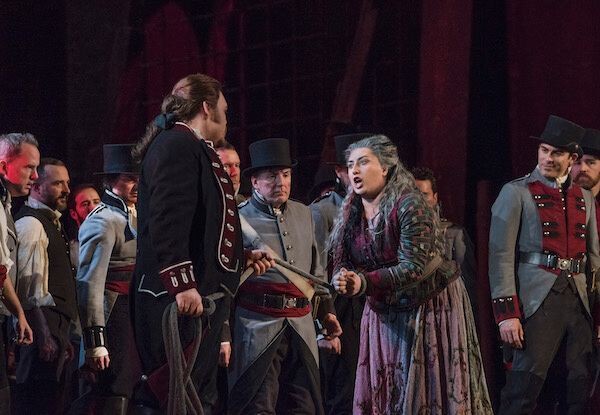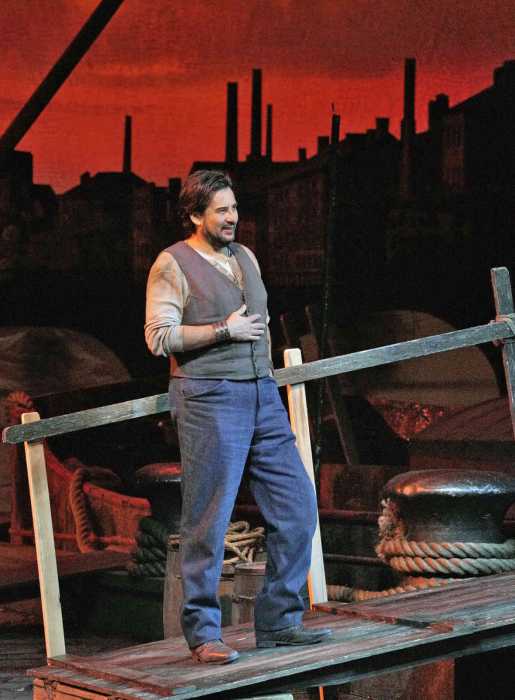Anita Rachvelishvili as Azucena faces off against Quinn Kelsey’s Conte di Luna in Verdi’s “Il Trovatore.” | KAREN ALMOND/ METROPOLITAN OPERA
In Verdi’s “Il Trovatore,” everyone is fighting with each other, everyone fights back, and everyone loses. Still, despite the dark, convoluted story, this is an exhilarating opera with one sensational tune after another.
This season’s Met revival of the David McVicar production featured one familiar performer (tenor Yonghoon Lee) with three rising Verdi singers new to their roles in this house. The standout audience favorite was mezzo-soprano Anita Rachvelishvili debuting as the crazed gypsy Azucena, whose thirst for revenge overwhelms her maternal instincts. In an interview, Rachvelishvili stated she wanted to bring her own individual stamp to the role and the aria “Stride la vampa” (new to her repertoire). She found her personal approach by carefully respecting the pianissimo dynamic markings in the score, routinely ignored by barnstorming mezzos. This scrupulous musicality informed her entire performance with many passages sung lyrically with a bel canto approach.
I was grateful for Rachvelishvili’s musicality and taste but this is “Il Trovatore” — there are certain passages in Azucena’s music that need to be burned in with uninhibited chest voice and blazing top. Rachvelishvili could have luxuriated a little more in the extremes of her big, vibrant mezzo voice — the character and the music demand it and the vocal resources are there. On the other hand, what a voice and what technical security! Her (still developing) characterization possesses convincing authority and humanity but seldom crosses over into larger-than-life obsession.
The Met’s winning “Il Trovatore” revival was musically on point
Also impressive in his Met role debut was burly voiced Hawaiian baritone Quinn Kelsey as a brutal Conte di Luna. Kelsey might be the man to revive the line of great American Verdi baritones at the Met and continue a tradition that ended with Sherrill Milnes. This is a broader, gruffer Verdi baritone, more in the line of a Cornell MacNeil than a velvety cantante like Robert Merrill. But like Rachvelishvili, Kelsey’s voice is absolutely the real thing as a Verdian instrument with a firm ringing top, unforced volume, and breadth of phrasing. The only thing lacking was bel canto finesse in “Il Balen,” but Kelsey’s energy, resonance, and projection more than made up for that. Kelsey and Rachvelishvili need to be given priority in future casting for the dramatic Italian repertory.
Soprano Jennifer Rowley stepped in for an indisposed Maria Agresta as the put-upon but rebellious heroine Leonora. (This seems to be a recurring theme in Rowley’s career, with breakthroughs as a last-minute replacement in the title role of “Maria di Rohan” at Caramoor and last season replacing Patricia Racette as Roxane in “Cyrano de Bergerac.”) An erstwhile lyric soprano, Rowley has only recently added spinto roles like Tosca (which she sang for one performance this season reportedly with great success) and the “Trovatore” Leonora, which she has sung in various theaters in France.
This precipitous assumption of heavy repertory seems to have added vocal weight at the expense of fine control in the upper register. Rowley has a full, blooming soprano with a velvety quality and round tone. Her opening aria “Tacea la notte” was sung with expansive, sensual phrasing but one or two exposed high C’s came out with tonal edge and spread. Rowley went on to cap the Act I trio “Di geloso amor sprezzato” with a stunning sustained high D flat. Rowley was, however, audibly tired by the Act IV prison scene, singing “D’amor sull’ali rosee” with edgy uncertain tones in the exposed high-lying phrases. She lost her way rhythmically in the “Miserere” and the cabaletta “Tu vedrai,” only getting back on track in the duet with Di Luna. Rowley needs to get her voice in line and concentrate on heavier bel canto and early Verdi repertory — leaving verismo roles for the future.
Tenor Yonghoon Lee never lost control as Manrico but his voice is monochromatic with a pressurized quality. He offers sturdy good phrasing and dependable technique but lacks tonal spin, and the color seems manufactured. He is a reliable house artist, not a star. Stefan Kocán is better suited to the lighter demands of Ferrando than the heavier Russian roles the Met casts him in that require more of a black bass.
Marco Armiliato conducted with vivacity and forward propulsion yet could accommodate the singers’ needs for rubato, cadenzas, and ritards. McVicar’s production is inspired by Goya and presents a violent, wartime landscape where extreme desperate acts are normalized. This requires some simulated violence and depravity for the principal singers and chorus. Rachvelishvili and Kelsey threw themselves into the action with convincing aggression, while Lee and Rowley alternated between stolid stand-and-sing presentation and dutifully awkward attempts at realistic acting. All in all, this was a winning revival with musical vitality and convincing vocal quality from top to bottom.






































